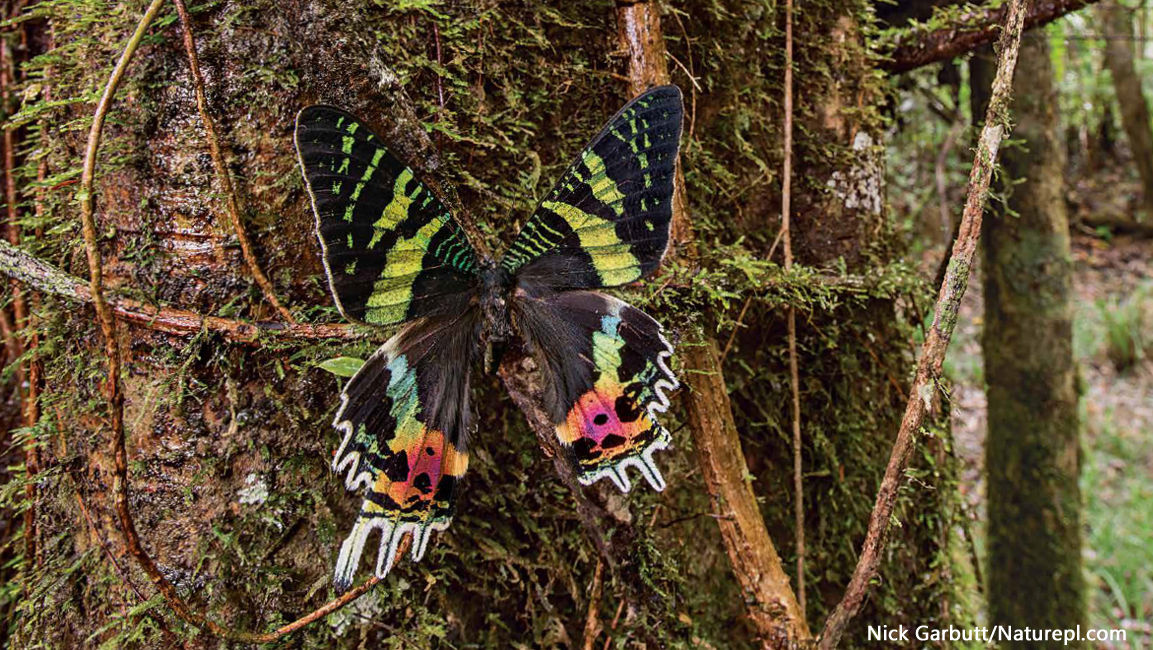
Colorful Moths
By Kathy KrankingMoths are plain and drab, right? Well, for some moths, that’s a myth!

Of course, these moths don’t really think they’re butterflies. But they sure do look like them. So how do you tell a moth from a butterfly? That’s something that isn’t exactly exact! Here, in general, are the main differences between the two:
• Male moths have feathery antennas. Butterflies’ antennas are thin and sometimes club-shaped at the ends.
• Most moths come out at night, but butterflies are out only during the day.
• Moths rest with their wings open and flat. Butterflies rest with their wings held together.
• Moths have thick, hairy bodies. Butterflies have thin, smooth bodies.
• Moths are plain. Butterflies are colorful.
But as the moths in this story prove, there are some exceptions to these rules! Keep reading to meet more “brighter-than-your-average moths”!

Pretty Poison
There’s an expression that says, “You are what you eat.” For the crimson-speckled moth, that’s true! This day-flying moth feeds on poisonous plants when it’s a caterpillar. The poisons don’t harm it. They stay in its body even after it becomes a moth. Those bright colors warn enemies that the moth may be a dangerous meal.
Hunt and Hover
The elephant hawk moth has very sensitive eyes that help it see color in the dark. Once it spies a flower, it uses its colorful wings to hover in front of it. The moth’s long tongue, called a proboscis (proh-BAH-sis), works as a straw to sip up the flower’s sweet nectar.
“Eye” See You
To try to scare an enemy away, the Io (EYE-oh) moth (1) quickly opens its forewings to show two big spots on its hindwings (2). The predator may be startled by what look like big, staring eyes, giving the moth time to escape.
Hide in Plain Sight
The pattern on the oleander (OH-lee-an-dur) hawk moth breaks up the outline of the moth, making it look less “moth-shaped.” And its colors help the moth to blend in with leaves. This disappearing act may help keep it safe from hungry enemies.
In Disguise
You might say the hornet clearwing is a moth that thinks it’s a butterfly that thinks it’s a hornet! The moth’s bright markings are like a “hornet costume.” It may scare off enemies that think they could be stung if they attack.

Egg-stravaganza
After mating, female moths usually lay eggs on plants that their young will eat when they hatch. Moth eggs come in a variety of shapes, from round—like these small emperor moth eggs—to oval to squarish. But there’s one thing they all have in common: Caterpillars hatch out of them!
Caterpillar Looks
As you can see by looking at this atlas moth (1) and its caterpillar (2), larvas can look very different from the adults they will become. Moth caterpillars come in a rainbow of colors and patterns. Some have spines, knobs, hairs, or other “decorations.” And some are camouflaged as other things, such as leaves or even bird droppings!
The Big Change
When the time is right, a moth caterpillar becomes a pupa (PYOO-puh), and some kinds spin a cocoon. Inside, lots of changes are going on. Soon the pupa has become an adult moth. It breaks out of its cocoon. At first its wings are crumpled and small like the wings of this Indian moon moth (1). But after a while the wings expand, and soon the moth will be ready to fly away (2).
MOTH LIFE CYCLE
-An adult moth lays eggs.
-A caterpillar hatches from each egg.
-After eating a lot and growing, each caterpillar becomes a pupa in a cocoon.
-The adult moth comes out of the cocoon!
















